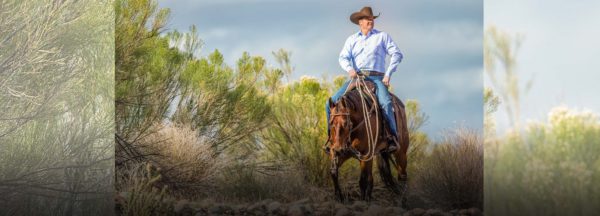Training Tip: Ask Clinton: Giving a Horse Confidence

Q: I am struggling with my older horse that is losing his confidence. Do you have any recommendations for me to get him back on track? I ride him about two to three times per week, and do some arena work but I mostly trail ride. When he is feeling insecure, I can talk him through it and he will always comply. How can I help him, he’s my pal? – Nina L.
A: The best way to help your horse is by becoming a leader for him and giving him a job to do. Horses want a leader and naturally look for somebody worthy to follow. A lack of leadership makes a horse feel uncomfortable. If you’re not willing to do the job, the horse will eventually step up to the plate and do it himself. When that happens, you have no control. Instead, your horse is in control of you, which puts you in a situation that can turn extremely dangerous.
A while back, I gave one of my performance horses to a friend, and eight months after having the horse, she called me and said she was having a problem with the horse spooking and bolting on the trail. She said she’d just be riding along and all of a sudden the horse would snort, jump sideways 15 feet and then take off. At first, he only did it once every three or four rides, but before long he was doing it every single time she took him out on the trail. The funny thing, she said, was that the horse was perfect in the arena. He was calm, responsive and soft.
I immediately knew what the problem was, but I wanted her to think through the solution, so I asked her to describe how she rode him down the trail. She said that oftentimes she’d go riding with a girlfriend and they’d get to chatting so they’d put the horses on a loose rein and let them walk down the trail. When I asked her how she rode the horse in the arena, she said, “Oh, I’m constantly moving his feet – sidepassing him, two-tracking him, backing him up, loping circles. I’m doing everything you showed me how to do, Clinton.”
In other words, she was being a leader for her horse in the arena – moving his feet and giving him a job to do – but on the trail, she wasn’t giving him any direction whatsoever. To fix her problem, she needed to give the horse a job to do on the trail. Circle around bushes, figure-8 between trees, sidepass down the trail, etc. She needed to be a leader for him on the trail just like she was being in the arena. She did exactly what I said and after just one ride she said the horse was back to being his usual calm, willing self on the trail, not spooking at anything.
The answer to your situation is the same – you need to give your horse a job to do – in other words, move his feet forwards, backwards, left and right. You’ll be amazed at how quiet he’ll get. Don’t let your horse walk down the trail without any direction, letting him look at everything, just thinking of what he could spook at.
